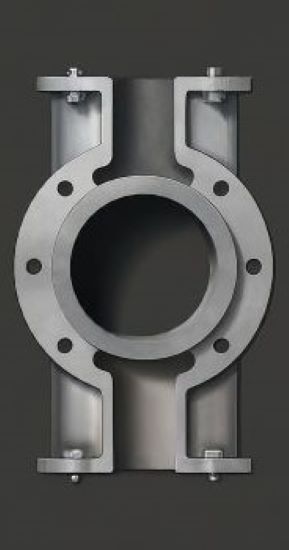Your car’s exhaust system plays a vital role in channeling harmful fumes away from the engine and the cabin. This system relies on various components that connect and work together seamlessly. One crucial element in this network is the exhaust flange.
But traditional flanges often require welding for installation and removal, making repairs a hassle. This is where exhaust split flanges come in!
Benefits of Using Exhaust Split Flanges
Imagine replacing a faulty exhaust component without dismantling the entire system! Exhaust split flanges offer this very advantage. Here’s why they’re a popular choice:
➡️ Ease of installation and removal: Unlike traditional flanges welded in place, split flanges come in two halves. This allows for quick and easy installation and removal without the need for complex welding equipment or skills.
➡️ Saves time and labor costs: By eliminating the welding process, split flanges significantly reduce repair time. This translates to lower labor costs, making them a budget-friendly option.
➡️ Allows for repairs and replacements: Need to replace a catalytic converter or another exhaust component? Split flanges make it a breeze. You can access the connection point without removing the entire exhaust system, saving time and effort.
Types of Exhaust Split Flanges
Exhaust split flanges come in various configurations to suit different applications. Here’s a quick breakdown:
➡️ Material: Stainless steel is a popular choice due to its superior resistance to rust and corrosion, making it ideal for harsh undercarriage environments. Mild steel is a more cost-effective option but may be more susceptible to rust over time.
➡️ Size and Design: Split flanges come in various diameters to match the size of the exhaust pipes they connect. They can also have different flange designs, such as flat or grooved, to ensure a proper seal with the gasket.
Applications of exhaust split flanges
Split flanges find use in various areas of your vehicle’s exhaust system. Common applications include:
1. Connecting the catalytic converter to the exhaust pipe: This is a frequent use case, as the catalytic converter is a critical emissions control component.
2. Joining exhaust system sections: Split flanges can be used to connect different sections of the exhaust piping for a secure and easily serviceable connection.
3. Specific applications: Depending on the vehicle make and model, split flanges might be used in other exhaust system connections, such as the connection between the exhaust manifold and the downpipe.
Signs that your exhaust split flange might need replacing:
A faulty exhaust split flange can lead to performance issues and unpleasant driving experiences. The following are warning signs to be mindful of:
➡️ Leaks or excessive exhaust noise: A leaking exhaust system will produce a noticeable increase in exhaust noise. This can sound like a hissing or rattling coming from underneath the car.
➡️ Visible cracks or damage on the flange: If you notice cracks, warping, or severe rust on the split flange, it’s best to replace it to prevent leaks and ensure proper exhaust flow.
➡️ Loose connection between exhaust components: A loose connection at the flange joint can indicate a worn-out gasket or a damaged flange itself. This can cause leaks and exhaust noise.
Replacing an Exhaust Split Flange
Disclaimer: While replacing a split flange can be a DIY project, consulting a qualified mechanic is always recommended, especially for complex repairs. However, if you’re comfortable working on your car and have the necessary tools, here’s a simplified guide:
1. Safety Precautions:
➡️ Always work in a well-ventilated area and wear safety glasses and gloves.
➡️ Prior to beginning any repairs, let the engine cool fully.
➡️ Be mindful of sharp edges on exhaust components.
2. Tools required:
➡️ Socket wrench set
➡️ Screwdrivers
➡️ Replacement exhaust split flange and gasket (ensure compatibility with your vehicle)
➡️ Wire brush (optional)
3. Replacement process:
➡️ Locate the split flange: Identify the flange you need to replace and ensure you have enough access for removal.
➡️ Disconnect the exhaust component: Depending on the location, you might need to loosen or remove brackets or hangers to access the flange connection.
➡️ Remove the old flange: Unscrew the bolts or nuts holding the two halves of the split flange together. You might need to use a penetrating lubricant if the bolts are seized.
➡️ Clean the mating surfaces (optional): Use a wire brush to clean any dirt or rust from the surfaces where the new flange will be placed.
➡️ Install the new gasket and flange: Position the new gasket correctly and secure the new split flange halves with the provided bolts or nuts. Tighten them gradually and evenly in a crisscross pattern.
➡️ Reconnect the exhaust component: Reattach any brackets or hangers you removed and ensure a secure fit.
Frequently Asked Questions (FAQ)
Q: Can I reuse an old exhaust split flange?
A: Generally, no. Flanges are designed to create a tight seal, and reusing an old one might compromise the seal and lead to leaks.
Q: How long do exhaust split flanges last?
A: The lifespan of a split flange depends on various factors like material quality, exposure to harsh elements, and driving habits. If maintained properly, they can usually endure for several years.
Q: What maintenance can I perform to extend the life of my exhaust split flanges?
A: Regularly inspect your exhaust system for signs of rust, leaks, or damage. Avoid harsh undercarriage washes that can accelerate corrosion.
Conclusion
If you suspect any issues with your exhaust system, such as leaks, strange noises, or decreased performance, don’t hesitate to get it checked by a qualified mechanic. You can avoid further harm and save money by detecting and repairing problems early.
Remember, a healthy exhaust system is essential for a clean and efficient running vehicle.
Post time: Jun-03-2024


